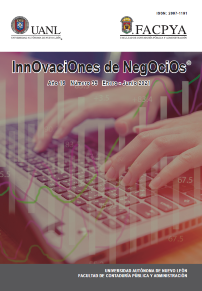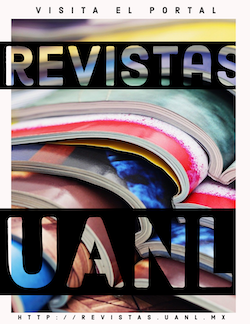Las medidas Covid-19 para la reapertura de restaurantes de servicio completo: el impacto en la intención de recomendación de boca en boca
DOI:
https://doi.org/10.29105/rinn18.35-e5Palabras clave:
Covid-19, word of mouth, restaurants, hospitality, pandemicResumen
In late December 2019, authorities in China spotted a large number of pneumonia cases of unknown cause, linked to a seafood market in Wuhan, Hubei Province, China (Zhu et al., 2020). These cases were the consequence of a novel virus, later named Covid-19, which spread all around the world, and was finally declared as a pandemic by the World Health Organization on
January 30, 2020. This changed the way the world works in several industries, including hospitality.
Descargas
Citas
Berkman, H. W. & Gilson, C. C. (1986). Consumer behavior: Concepts and
strategies. Thomson South-Western.
Bujisic, M., Hutchinson, J. & Parsa, H. G. (2014). The effects of restaurant
quality attributes on customer behavioral intentions. International Journal of
Contemporary Hospitality Management, 26(8), 1270-1291.
Chen, S. C. (2012). The customer satisfaction-loyalty relation in an interactive
e-service setting: the mediators. Journal of Retailing and Consumer
Services, 19(2), 202-210.
Emde, M. & Fuchs, M. (2012). Exploring Animated Faces Scales in Web
Surveys: Drawbacks and Prospects. Survey Practice, 5(1), 1-6.
Fornell, C. & Larcker, D. F. (1981). Evaluating structural equation models with
unobservable variables and measurement error. Journal of Marketing
Research, 18(1), 39-50.
Freimuth, V. S., Musa, D., Hilyard, K., Quinn, S. C. & Kim, K. (2014). Trust
during the early stages of the 2009 H1N1 pandemic. Journal of Health
Communication, 19(3), 321-339.
Garvin, D. A. (1984). What does “product quality” really mean. Sloan
Management Review, 25.
Garvin, D. A. (1987). Competing on the eight dimensions of quality.
Ha, J. & Jang, S. C. S. (2010). Effects of service quality and food quality: the
moderating role of atmospherics in an ethnic restaurant segment.
International Journal of Hospitality Management, 29(3), 520-529.
Hair, J. F., Black, W. C., Babin, B. J. & Anderson, R. E. (2010). Multivariate Data
Analysis. New Jersey: Pearson Prentice Hall.
Han, H. & Ryu, K. (2012). Key factors driving customers’ word-of-mouth
intentions in full-service restaurants: The moderating role of switching
costs. Cornell Hospitality Quarterly, 53(2), 96-109.
Harker, M. J. & Egan, J. (2006). The past, present and future of relationship
marketing. Journal of Marketing Management, 22(1), 215-242.
Hu, L. T. & Bentler, P. M. (1999). Cutoff criteria for fit indexes in covariance
structure analysis: Conventional criteria versus new alternatives. Structural
Equation Modeling, 6(1), 1-55.
Kim, D. J., Ferrin, D. L. & Rao, H. R. (2008). A trust-based consumer decisionmaking model in electronic commerce: The role of trust, perceived risk, and
their antecedents. Decision Support Systems, 44(2), 544-564.
Kim, W. G., Han, J. S. & Lee, E. (2001). Effects of relationship marketing on
repeat purchase and word of mouth. Journal of Hospitality & Tourism
Research, 25(3), 272-288.
Knutson, B. J. (1988). Ten laws of customer satisfaction. Cornell Hotel and
Restaurant Administration Quarterly, 29(3), 14-17.
Kramer, A. & Kramer, K. Z. (2020). The potential impact of the Covid-19
pandemic on occupational status, work from home, and occupational
mobility. Journal of Vocational Behavior, 119, 103442.
Ling, K. C., Chai, L. T. & Piew, T. H. (2010). The effects of shopping orientations,
online trust and prior online purchase experience toward customers' online
purchase intention. International Business Research, 3(3), 63.
Litvin, S. W., Goldsmith, R. E. & Pan, B. (2008). Electronic word-of-mouth in
hospitality and tourism management. Tourism Management, 29(3), 458-
Longart, P. (2010). What drives word-of-mouth in restaurants? International
Journal of Contemporary Hospitality Management, 22(1), 121-128.
Longstaff, P. H. & Yang, S. U. (2008). Communication management and trust:
their role in building resilience to “surprises” such as natural disasters,
pandemic flu, and terrorism. Ecology and Society, 13(1), 3.
Lovelock, C. H. (2000). Service marketing (4th ed.). NJ: Prentice Hall
International.
Mattila, A. S. (2001). Emotional bonding and restaurant loyalty. The Cornell
Hotel and Restaurant Administration Quarterly, 42(6), 73-79.
Namkung, Y. & Jang, S. C. (2007). Does food quality really matter in
restaurants? Its impact on customer satisfaction and behavioral intentions.
Journal of Hospitality & Tourism Research, 31(3), 387-410.
National Restaurant Association. (2020). Total Restaurant Industry
Jobs. Retrieved from
https://restaurant.org/research/economy/indicators/restaurant-sales
Price, L. L. & Arnould, E. J. (1999). Commercial friendships: Service provider–
client relationships in context. Journal of Marketing, 63(4), 38-56.
Ryu, K., Han, H. & Kim, T.-H. (2007). The relationships among overall quick
casual restaurant image, perceived value, customer satisfaction, and
behavioral intentions. International Journal of Hospitality Management,
(3), 459-469.
Descargas
Publicado
Cómo citar
Número
Sección
Licencia
Derechos de autor 2021 Innovaciones de Negocios

Esta obra está bajo una licencia internacional Creative Commons Atribución-NoComercial-CompartirIgual 4.0.
La revista InnOvaciOnes de NegOciOs es una revista electrónica gratuita y de acceso abierto de carácter científico-académico y es una publicación de la Universidad Autónoma de Nuevo León, en la cual los autores conservan sus derechos de autor y otorgan a la revista el derecho exclusivo de primera publicación del trabajo. Se permite que terceros utilicen el contenido publicado, siempre y cuando se reconozca la autoría del trabajo y se cite la primera publicación en esta revista.
Para mayor información favor de comunicar a la Secretaria de Investigación (FACPyA) de la Universidad Autónoma de Nuevo León. Teléfono: (81) 1340-4431. Correo electrónico: revinnova.negocios@uanl.mx










